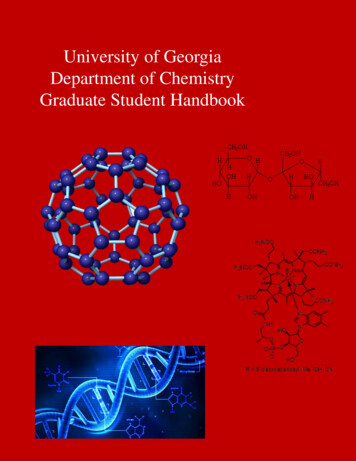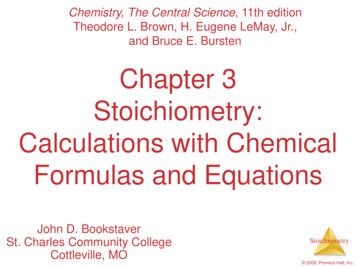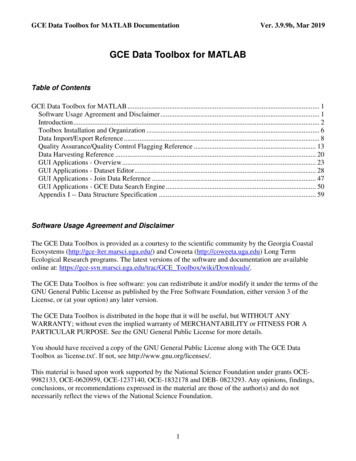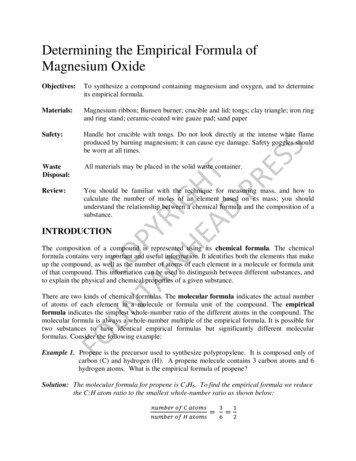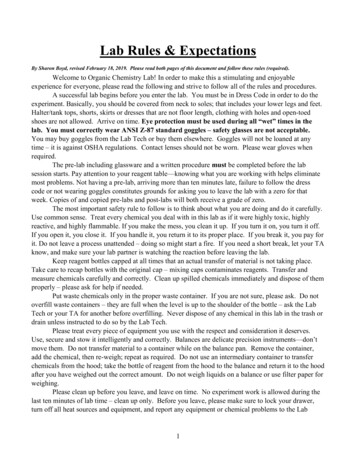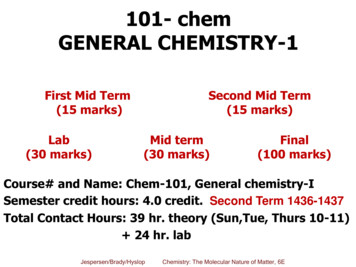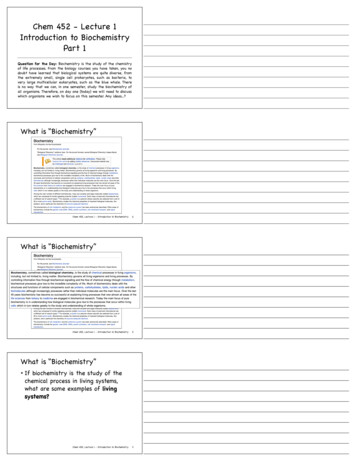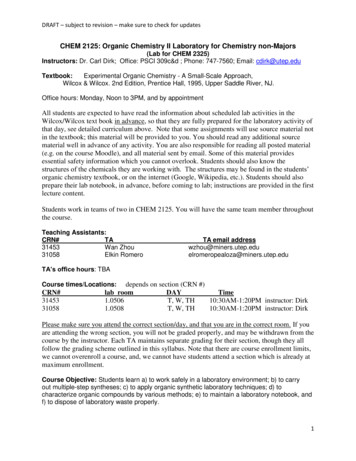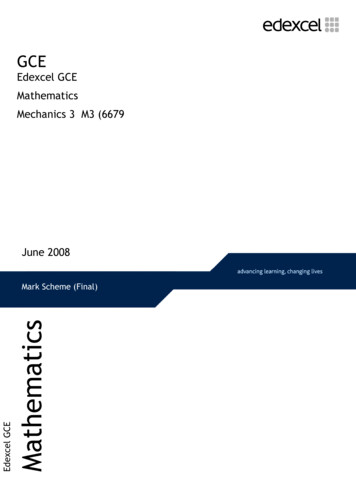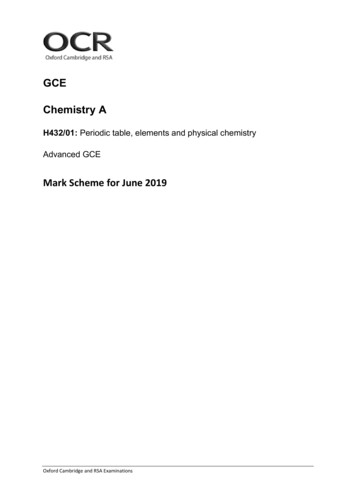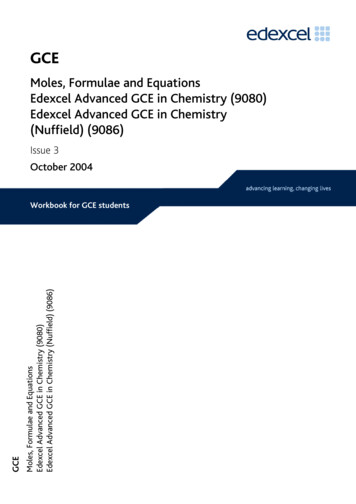
Transcription
GCEMoles, Formulae and EquationsEdexcel Advanced GCE in Chemistry (9080)Edexcel Advanced GCE in Chemistry(Nuffield) (9086)Issue 3October 2004Moles, Formulae and EquationsEdexcel Advanced GCE in Chemistry (9080)Edexcel Advanced GCE in Chemistry (Nuffield) (9086)GCEWorkbook for GCE students
London Qualifications is one of the leading examining and awarding bodies in the UK andthroughout the world. It incorporates all the qualifications previously awarded under theEdexcel and BTEC brand. We provide a wide range of qualifications including general(academic), vocational, occupational and specific programmes for employers.Through a network of UK and overseas offices, our centres receive the support they need tohelp them deliver their education and training programmes to learners.For further information please call Customer Services on 0870 240 9800, or visit our website atwww.edexcel.org.ukAuthorised by Jim DobsonPrepared by Sarah HarrisonPublications code UA008883All the material in this publication is copyright London Qualifications Limited 2004
IntroductionThis workbook has been developed from an earlier version offering support to students intransition from GCSE Science (Double Award) and the GCE Advanced Subsidiary.The aim of the booklet is to help students to practise their skills in the areas of formulae,equations and simple mole equations. The booklet gives examples for students to work throughto help build their confidence. There are some sections involving multi-step calculations.Edexcel acknowledges the help and support received from teachers in updating this latestedition. It replaces previous versions issued in January 1998 and August 2000.
ContentsSection 1Section 2Section 3Section 4Section 5Section 6Section 7Atoms1Exercise 1 Calculation of Molar Mass of compounds5Chemical formulae9Exercise 2 Writing formulae from names13Naming of compounds19Exercise 3 Names from formulae23The mole27Exercise 4a Calculation of the number of moles of material in agiven mass of that material33Exercise 4b Calculation of the mass of material in a givennumber of moles of that material37Exercise 4c Calculation of the volume of a given number ofmoles of a gas41Exercise 4d Calculation of the number of moles of gas in a givenvolume of that gas43Exercise 4e Calculation of the mass of a given volume of gas45Exercise 4f Calculation of the volume of a given mass of gas47Exercise 4g Calculation of the Relative Molecular Mass of a gasfrom mass and volume data for the gas49Using the idea of moles to find formulae51Exercise 5 Calculation of formulae from experimental data57Chemical equations; equations in words;writing formulae; balancing the equation63Exercise 6a Balancing equations65Exercise 6b What’s wrong here?69Exercise 6c Writing equations in symbols from equations inwords71How equations are found by experiment73Exercise 7 Writing equations from experimental data77
Section 8Section 9Section 10Section 11Section 12AnswersAmounts of Substances79Exercise 8 Calculations of amounts of products/reactants basedon equations83Reactions involving gases87Exercise 9 Calculations based on equations involving only gases89Ions and ionic equations; structure of ioniccompounds93Exercise 10 Ionic equations95Calculations involving chemicals in solution97Exercise 11a Calculations based on concentrations in solution105Exercise 11b Simple volumetric calculations109Data — The periodic table113115
Section 1AtomsAll matter is made of particles. At one time, it was thought that the tiniest particle was the atom;the word comes from the Greek word meaning ‘indivisible’.We now know that atoms can be split and that there are smaller particles than atoms, the socalled sub-atomic particles, electrons, protons and neutrons. You will need to know somethingabout these particles which make up the different kinds of atoms.However, you must understand that chemistry is all about rearrangements of atoms that do notthemselves change.Atoms are very small. The hydrogen atom, the smallest and lightest of all atoms, has a diameterof about 108 mm. 1 g of hydrogen atoms contains about 6 x 1023 atoms. It is very difficult to‘see’ an individual atom and to find its mass.An atom is the smallest, electrically neutral, particle of an element that can take part in achemical change.A molecule is the smallest, electrically neutral, particle of an element or compound thatcan exist on its own.An ion is an atom, or group of atoms, which carries an electric charge.You need to know these definitions by heart, but you also need to be able to recognise theformulae of atoms and molecules when you see them. Li, O, Cl, C are all formulae whichrepresent atoms. Some of these can exist on their own, but not all of them. Oxygen, for example,always exists as oxygen molecules, O2, which contain two atoms, unless it is combined withsomething else. Water contains only one atom of oxygen but here it is combined with twohydrogen atoms.Make sure that you really understand these ideas: a single oxygen atom, O, cannot exist on its own a single oxygen atom can exist when it is combined with something else, but then it is partof a molecule an oxygen molecule has two oxygen atoms, O2 a few elements exist as single atoms: for these elements, an atom is the same as a molecule.UA008883 – Workbook for GCE students – Moles, Formulae and EquationsEdexcel Advanced GCE in Chemistry (9080)Edexcel Advanced GCE in Chemistry (Nuffield) (9086) – Issue 3 – October 20041
Structure of the atomThe atom is composed of electrons, neutrons and protons. You have to remember the relativemass of, and the electric charge on, each.ParticleRelative mass(Carbon -12 scale)Relative charge (on scaleelectron charge -1 unit)Proton1 1Electron1/1840–1Neutron10The atom is mostly empty space. It has a solid core or nucleus, the centre that contains theprotons and neutrons. The electrons circulate round the nucleus in specific orbits or shells.We can picture the hydrogen atom - the simplest of all atoms with one electron, and one protonin the nucleus - by considering a pea placed in the centre of a football pitch, to represent thenucleus with its proton. On this scale the electron will revolve in a circular orbit round the goalposts. Between the electron and the nucleus is empty space.Atoms are the particles whose symbols are found in the periodic table given in all yourexamination papers and also on page 113 of this book. You can see there are only about 100 ofthem. The middle part of the atom, the nucleus, contains one or more protons. It is the numberof protons that make the atom what it is. An atom with one proton is always a hydrogen atom;one with two protons is a helium atom and so on.There are more substances in the world than the 100 or so different kinds of atom. The othersubstances are made by combining atoms in various ways to make molecules.When a chemical reaction takes place the atoms are rearranged to make different molecules butno atoms can be made or destroyed. To show this you have to be able to find a method ofcounting the atoms that take part in a reaction and its products.The mass of an individual atom is very small and it is much more convenient to measure atomicmasses as relative masses.The definition of relative atomic mass Ar is:The mass of a single atom on a scale on which the mass of an atom of carbon — 12 has amass of 12 atomic mass units. The relative atomic mass does not have units.The definition of Relative Molecular Mass Mr (also referred to as Molar Mass) isThe mass of a single molecule on a scale on which the mass of an atom of carbon — 12 hasa mass of 12 atomic mass units.Relative Molecular Mass of a molecule is calculated by adding together the relative atomicmasses of the atoms in the chemical formulae.Relative formula mass: in many ways this is more accurate than Relative Molecular Mass. Manysalts, even in the solid state, exist as ions rather than molecules. Although the formula of sodiumchloride is normally given as NaCl, it is not a simple molecule but a giant lattice and it is moreaccurately written as (Na Cl–)n. Since this compound does not have molecules, it cannot haverelative ‘molecular’ mass. However, the principle is the same: add the relative atomic masses ofsodium (23) and chlorine (35.5) to give 58.5, the relative formula mass of NaCl.Remember: relative atomic mass, molecular mass and formula mass have no units.2UA008883 – Workbook for GCE students – Moles, Formulae and EquationsEdexcel Advanced GCE in Chemistry (9080)Edexcel Advanced GCE in Chemistry (Nuffield) (9086) – Issue 3 – October 2004
Examples: Calculation of Molar Mass from Relative Atomic Mass dataBefore you start any of these questions make sure you read the Section 4 of this booklet(The mole on page 27).When you carry out experiments you will weigh chemicals in grams. Molar mass has the samenumerical value as the Relative Molecular Mass; it is calculated by adding together the relativeatomic masses of the elements in the molecule. The total is expressed in units of grams per molor g mol-1.Example 1Calculate the Molar Mass of sulphuric acid H2SO4This molecule contains2 atoms of hydrogen each of mass 1 2x 1 2 g mol–11 atom of sulphur of mass 32 1 x 32 32 g mol–14 atoms of oxygen of mass 16 4 x 16 64 g mol–1Total mass 98 g mol–11 atom of lead of mass 207 1 x 207 207 g mol–12 atoms of nitrogen of mass 14 2 x 14 28 g mol–16 atoms of oxygen of mass 16 6 x 16 96 g mol–1Total mass 331 g mol–1Example 2Calculate the Molar Mass of lead nitrate Pb(NO3)2Care! This molecule contains TWO nitrate groupsExample 3Calculate the Molar Mass of CuSO4.5H2OCare! This molecule has 5 molecules of water attached to each molecule of copper sulphate.Many students make the mistake of thinking that there are 10 hydrogens and only 1 oxygen.In CuSO4In 5H2O1 atom of copper of mass 63.5 1 x 63.5 63.5 g mol–11 atom of sulphur of mass 32 1 x 32 32 g mol–14 atoms of oxygen of mass 16 4 x 16 64 g mol–15 x 2 atoms of hydrogen of mass 1 10 x 1 10 g mol–15 x 1 atoms of oxygen of mass 16 5 x 16 80 g mol–1Total mass 249.5 g mol–1Calculations of this type are generally written as followsCuSO4.5H2O [ 63.5 32 (4 x 16) 5{(2x1) 16} ] 249.5 g mol–1UA008883 – Workbook for GCE students – Moles, Formulae and EquationsEdexcel Advanced GCE in Chemistry (9080)Edexcel Advanced GCE in Chemistry (Nuffield) (9086) – Issue 3 – October 20043
4UA008883 – Workbook for GCE students – Moles, Formulae and EquationsEdexcel Advanced GCE in Chemistry (9080)Edexcel Advanced GCE in Chemistry (Nuffield) (9086) – Issue 3 – October 2004
Exercise 1Calculation of the Molar Mass of compoundsCalculate the Molar Mass of the following. You will find data concerning Relative AtomicMasses on the periodic table (on page 113). When you have finished this set of calculationskeep the answers for reference. You will find them useful in some of the other questions in nO417K2CrO418KHCO319KI20CsNO321CaCl2UA008883 – Workbook for GCE students – Moles, Formulae and EquationsEdexcel Advanced GCE in Chemistry (9080)Edexcel Advanced GCE in Chemistry (Nuffield) (9086) – Issue 3 – October 20045
lO348KIO3UA008883 – Workbook for GCE students – Moles, Formulae and EquationsEdexcel Advanced GCE in Chemistry (9080)Edexcel Advanced GCE in Chemistry (Nuffield) (9086) – Issue 3 – October 2004
2HUA008883 – Workbook for GCE students – Moles, Formulae and EquationsEdexcel Advanced GCE in Chemistry (9080)Edexcel Advanced GCE in Chemistry (Nuffield) (9086) – Issue 3 – October 20047
8UA008883 – Workbook for GCE students – Moles, Formulae and EquationsEdexcel Advanced GCE in Chemistry (9080)Edexcel Advanced GCE in Chemistry (Nuffield) (9086) – Issue 3 – October 2004
Section 2Chemical formulaeA chemical formula is a useful shorthand method for describing the atoms in a chemical:sometimes you will see the formula used instead of the name, but you should not do this if youare asked for a name.The chemical formula of an element or compound tells you: Which elements it contains: eg FeSO4 contains iron, sulphur and oxygen How many atoms of each kind are in each molecule: eg H2SO4 contains two atoms ofhydrogen, one atom of sulphur and four atoms of oxygen in each molecule How the atoms are arranged: eg C2H5OH contains a group of atoms known as the ethylgroup, -C2H5, and a hydroxyl group, -OH The masses of the various elements in a compound: eg 18 g of water, H2O, contains 2 g ofhydrogen atoms and 16 g of oxygen since the relative atomic mass of hydrogen is 1 (x 2because there two hydrogen atoms) and that of oxygen is 16.You should not learn large numbers of chemical formulae by heart. However, it is useful toknow a few of them and when you do you should be able to work out the rest. The table on page10 shows the names, formulae and valency of the more common elements and some groups ofatoms, called radicals, that you will study and you should refer to it when necessary.Although it’s best to learn formulae by using the valency of the common parts, it is sometimesuseful to be able to work out the formula of a compound. This set of rules helps you to do thisusing information in the table.You can think of valency as the combining power and use it to show the simplest ratio in whichthe atoms of the elements and radicals combine together in the formula. The following rules cannow be applied: Write down the symbols of the elements and radicals given in the chemical name of thecompound Now write down the valency of each element or radical under the corresponding symbolsfor the element or radical Now cross them over as shown in the example on page 10 The valency shows the simplest combining ratio and may be cancelled down but only thevalency can be simplified in this way If an element has more than one valency, the name of the compound will indicate whichvalency is to be used.UA008883 – Workbook for GCE students – Moles, Formulae and EquationsEdexcel Advanced GCE in Chemistry (9080)Edexcel Advanced GCE in Chemistry (Nuffield) (9086) – Issue 3 – October 20049
Here are a few examples: Sodium SulphateNaSO4 2 Na2SO41Calcium hydrogen carbonateCa(HCO3) 2Ca(HCO3)21Note:A bracket must be placed around the radical if it is multiplied by 2 or more andcomposed of more than one element.EgMgBr2 no bracket requiredCa(OH)2 bracket essential as CaOH2 is incorrect. Often you can cancel the numbers on the two formulae:Ca2(CO3)2 CaCO3However, you should not do this for organic compounds: C2H4 has two atomsof carbon and four of hydrogen so it cannot be cancelled down to CH2. Copper(I) oxide means use copper valency 1, ie Cu2O: lead(II) nitrate means use leadvalency 2, ie Pb(NO3)2The periodic table can help you to find the valency of an element and hence the formula of itscompounds.Although you can use the table above to work out the formulae of many compounds it isimportant to realise that all formulae were originally found by experiment.On page 11 you will find a table of the more common elements and groups that you may havemet at GCSE. Also included are a few that you will meet in the first few weeks of yourAdvanced course or are mentioned in some of the calculations in this booklet. These are initalics.10UA008883 – Workbook for GCE students – Moles, Formulae and EquationsEdexcel Advanced GCE in Chemistry (9080)Edexcel Advanced GCE in Chemistry (Nuffield) (9086) – Issue 3 – October 2004
Symbols and Valences of Common Elements and SilverAg1SodiumNa1SulphurS2,4,6UA008883 – Workbook for GCE students – Moles, Formulae and EquationsEdexcel Advanced GCE in Chemistry (9080)Edexcel Advanced GCE in Chemistry (Nuffield) (9086) – Issue 3 – October 200411
12UA008883 – Workbook for GCE students – Moles, Formulae and EquationsEdexcel Advanced GCE in Chemistry (9080)Edexcel Advanced GCE in Chemistry (Nuffield) (9086) – Issue 3 – October 2004
Exercise 2Writing formulae from namesUse the data in the table on page 11 to write the formulae of the following. Before you start thisexercise, make sure you have read Section 3 (Naming of compounds on page 19) of this booklet.1Sodium Chloride2Sodium Hydroxide3Sodium Carbonate4Sodium Sulphate5Sodium Phosphate6Potassium Chloride7Potassium Bromide8Potassium Iodide9Potassium Hydrogen Carbonate10Potassium Nitrite11Magnesium Chloride12Magnesium Nitrate13Magnesium Hydroxide14Magnesium Oxide15Magnesium CarbonateUA008883 – Workbook for GCE students – Moles, Formulae and EquationsEdexcel Advanced GCE in Chemistry (9080)Edexcel Advanced GCE in Chemistry (Nuffield) (9086) – Issue 3 – October 200413
16Calcium Oxide17Calcium Chloride18Calcium Sulphate19Calcium Carbonate20Barium Chloride21Barium Sulphate22Aluminium Chloride23Aluminium Oxide24Aluminium Hydroxide25Aluminium Sulphate26Copper(II) Sulphate27Copper(II) Oxide28Copper(II) Chloride29Copper(II) Nitrate30Copper(I) Oxide31Copper(I) Chloride32Zinc Nitrate33Zinc Carbonate14UA008883 – Workbook for GCE students – Moles, Formulae and EquationsEdexcel Advanced GCE in Chemistry (9080)Edexcel Advanced GCE in Chemistry (Nuffield) (9086) – Issue 3 – October 2004
34Zinc Oxide35Silver Chloride36Silver Bromide37Silver Iodide38Silver Nitrate39Silver Oxide40Lead(II) Nitrate41Lead(II) Carbonate42Lead(II) Oxide43Lead(IV) Oxide44Lead(II) Chloride45Lead(IV) Chloride46Lead(II) Sulphide47Tin(II) Chloride48Tin(IV) Chloride49Iron(II) Sulphate50Iron(II) Chloride51Iron(III) Sulphate52Iron(III) ChlorideUA008883 – Workbook for GCE students – Moles, Formulae and EquationsEdexcel Advanced GCE in Chemistry (9080)Edexcel Advanced GCE in Chemistry (Nuffield) (9086) – Issue 3 – October 200415
53Iron(III) Hydroxide54Iron(II) Hydroxide55Ammonium Chloride56Ammonium Carbonate57Ammonium Hydroxide58Ammonium Nitrate59Ammonium Sulphate60Ammonium Phosphate61Phosphorus Trichloride62Phosphorus Pentachloride63Phosphorus Trioxide64Phosphorus Pentoxide65Hydrogen Phosphate (Phosphoric Acid)66Hydrogen Sulphate (Sulphuric Acid)67Hydrogen Nitrate (Nitric Acid)68Hydrogen Chloride (Hydrochloric Acid)69Carbon Tetrachloride70Silicon Tetrachloride16UA008883 – Workbook for GCE students – Moles, Formulae and EquationsEdexcel Advanced GCE in Chemistry (9080)Edexcel Advanced GCE in Chemistry (Nuffield) (9086) – Issue 3 – October 2004
71Silicon Dioxide72Sulphur Dioxide73Sulphur Trioxide74Hydrogen Sulphide75Chlorine(I) Oxide76Nitrogen Dioxide77Nitrogen Monoxide78Carbon Dioxide79Carbon Monoxide80Hydrogen HydroxideUA008883 – Workbook for GCE students – Moles, Formulae and EquationsEdexcel Advanced GCE in Chemistry (9080)Edexcel Advanced GCE in Chemistry (Nuffield) (9086) – Issue 3 – October 200417
18UA008883 – Workbook for GCE students – Moles, Formulae and EquationsEdexcel Advanced GCE in Chemistry (9080)Edexcel Advanced GCE in Chemistry (Nuffield) (9086) – Issue 3 – October 2004
Section 3Naming of compoundsAt Advanced Level you will meet many compounds that are new to you; a lot of these will beorganic compounds. In this section, we will be looking at the naming of compounds that youmay already have met at GCSE level. Many of these compounds are named using simple rules.However, there are some that have ‘trivial’ names not fixed by the rules. It is important that youlearn the names and formulae of these compounds. Later in the course, you will learn the rulesfor naming most of the organic compounds you will meet.Naming inorganic compoundsThe name must show which elements are present and, where confusion is possible, the valencyof the elements concerned.1You need to remember that if there are only two elements present then the name will end in-ideThus, oxides contain an element and oxygenegNa2OisSodium OxideCaOisCalcium OxideChlorides contain an element and chlorineegMgCl2isMagnesium ChlorideAlCl3isAluminium ChlorideBromides and Iodides have an element and either bromine or iodineegKBrisPotassium BromideZnIisZinc IodideHydrides contain an element and hydrogen and Nitrides an element and nitrogen.egLiHisLithium HydrideMg3N2isMagnesium NitrideOther elements also form these types of compounds and the name always ends in -ide. Theexceptions to this are hydroxides that have the -OH group and cyanides, which have the-CN group.egNaOHisSodium HydroxideCa(OH)2isCalcium HydroxideKCNisPotassium CyanideUA008883 – Workbook for GCE students – Moles, Formulae and EquationsEdexcel Advanced GCE in Chemistry (9080)Edexcel Advanced GCE in Chemistry (Nuffield) (9086) – Issue 3 – October 200419
2eg3egIf the elements concerned have more than one valency this may need to be shown. Thus asiron has valency 2 and 3, the name Iron Chloride would not tell you which of the twopossible compounds FeCl2 or FeCl3 is being considered. In this case the valency of the ironis indicated by the use of a Roman II or III in brackets after the name of the metal. In thiscase Iron(II) Chloride for FeCl2 or Iron(III) Chloride for FeCl3.PbCl2isLead(II) ChloridePbCl4isLead(IV) ChlorideFe(OH)2isIron(II) HydroxideMn(OH)2isManganese(II) HydroxideFor compounds containing two non-metal atoms the actual number of atoms of the elementpresent are stated.COisCarbon Monoxide where mon- means oneCO2isCarbon Dioxide where di- means twoSO2isSulphur Dioxide. This could be called Sulphur(IV) OxideSO3isSulphur Trioxide. This could be called Sulphur(VI) OxidePCl3isPhosphorus Trichloride.This could be called Phosphorus(III) ChloridePCl5isPhosphorus Pentachloride.This could be called Phosphorus(V) Chloride4CCl4isCarbon Tetrachloride andSiCl4isSilicon Tetrachloride.Where a compound contains a metal, a non-metal and oxygen it has a name ending in -ateor -ite. You need to remember the names and formulae of the groups listed on page 11. Tocover the ideas we will look at the following groupsCarbonate-CO3Sulphate-SO4Nitrate-NO3Thus a compound of sodium, carbon and oxygen would be Na2CO3 and would be calledSodium Carbonate.eg20NaNO3isSodium NitrateMg(NO3)2isMagnesium NitrateFe2(SO4)3isIron(III) SulphateFeSO4isIron(II) SulphateUA008883 – Workbook for GCE students – Moles, Formulae and EquationsEdexcel Advanced GCE in Chemistry (9080)Edexcel Advanced GCE in Chemistry (Nuffield) (9086) – Issue 3 – October 2004
5Because most non-metals can have more than one valency they can also produce more thanone acid upon which these groups are based. Thus sulphur can form sulphates andsulphites. The ending -ite is used when an element forms more than one such compound. Inall cases the -ite is used for the compound with the lower number of oxygens atoms.Sulphate can also be referred to as sulphate(VI) and sulphite can also be referred to assulphate(IV). In the case of nitrogen with oxygen the compounds would be nitrate andnitrite or nitrate(V) and nitrate(III).In summary:Common nameSystematic )-ClOGreat care needs to be taken when using these systematic names, as they are called, because theproperties of the two groups of compounds will be very different. In some cases the use of thewrong compound in a reaction could cause considerable danger. For this reason you shouldalways read the label on a bottle or jar and make sure it corresponds exactly to what you shouldbe using.Other elements can form compounds involving oxygen in this way. These include Chlorate(V),Chromate(VI), Manganate(VII) and Phosphate(V).eg6egKNO2isPotassium Nitrite or Potassium Nitrate(III)Na2SO3isSodium Sulphite or Sodium Sulphate(IV)K2CrO4isPotassium Chromate(VI)KMnO4isPotassium Manganate(VII)KClO3isPotassium Chlorate(V)When a compound is considered it is usual to put the metal down first both in the name andthe formula. The exceptions to this rule are in organic compounds where the name has themetal first but the formula has the metal at the end.CH3COONa isSodium EthanoateUA008883 – Workbook for GCE students – Moles, Formulae and EquationsEdexcel Advanced GCE in Chemistry (9080)Edexcel Advanced GCE in Chemistry (Nuffield) (9086) – Issue 3 – October 200421
7eg8The elements nitrogen and hydrogen can join together to form a group called theammonium group. This must not be confused with the compound ammonia, but more ofthat later. This ammonium group has the formula NH4 and sits in the place generally takenby a metal in the formula.NH4ClisAmmonium Chloride(NH4)2SO4isAmmonium SulphateNH4ClO3isAmmonium Chlorate(V)There are a small number of simple molecules that do not follow the above rules. You willneed to learn their names and formulae.They include:Water which is H2OSulphuric Acid which is H2SO4Nitric Acid which is HNO3Hydrochloric Acid which is HClAmmonia which is NH3Methane which is CH48Organic compounds have their own set of rules for naming but you will need to learn someof the basic rules. The names are generally based on the names of the simple hydrocarbons.These follow a simple pattern after the first four:CH4 isMethaneC2H6 isEthaneC3H8 isPropaneC4H10 isButaneAfter butane the names are based on the prefix for the number of carbons C5-pent, C6 - hex andso on.Thus organic compounds with 2 carbons will either start with Eth- or have -eth- in their oic AcidC2H5ClisChloroethaneUA008883 – Workbook for GCE students – Moles, Formulae and EquationsEdexcel Advanced GCE in Chemistry (9080)Edexcel Advanced GCE in Chemistry (Nuffield) (9086) – Issue 3 – October 2004
Exercise 3Names from formulaeUse the notes in this section, the data in the table on page 11 and the copy of the periodic tableon page 113 to write the names of the following. Before you start this exercise make sure youhave read Section 2 of this booklet (Chemical formulae on page SO421CaCl222Ca(NO3)223Ca(OH)2UA008883 – Workbook for GCE students – Moles, Formulae and EquationsEdexcel Advanced GCE in Chemistry (9080)Edexcel Advanced GCE in Chemistry (Nuffield) (9086) – Issue 3 – October 200423
NO344NH4Cl45(NH4)2SO446NH4VO3 (V is Vanadium)47KClO348KIO349NaClO50NaNO224UA008883 – Workbook for GCE students – Moles, Formulae and EquationsEdexcel Advanced GCE in Chemistry (9080)Edexcel Advanced GCE in Chemistry (Nuffield) (9086) – Issue 3 – October 2004
CO358KI59Co(NO3)260KAtUA008883 – Workbook for GCE students – Moles, Formulae and EquationsEdexcel Advanced GCE in Chemistry (9080)Edexcel Advanced GCE in Chemistry (Nuffield) (9086) – Issue 3 – October 200425
26UA008883 – Workbook for GCE students – Moles, Formulae and EquationsEdexcel Advanced GCE in Chemistry (9080)Edexcel Advanced GCE in Chemistry (Nuffield) (9086) – Issue 3 – October 2004
Section 4The moleWhen chemists measure how much of a particular chemical reacts they measure the amount ingrams; or they measure the volume of a gas. However, chemists find it convenient to use a unitcalled a mole. You need to know several definitions of a mole and be able to use them. The mole is the amount of substance, which contains the same number of particles (atoms,ions, molecules, formulae or electrons) as there are carbon atoms in 12 g of carbon -12 This number is known as the Avogadro constant, L, and is equal to 6.02 x 1023 mol–1 The molar mass of a substance is the mass, in grams, of one mole The molar volume of a gas is the volume occupied by one mole at room temperature andatmospheric pressure (r.t.p). It is equal to 24 dm3 at r.t.p Avogadro’s Law states that equal volumes of all gases, under the same conditions oftemperature and pressure contain the same number of moles or molecules. If the volume is24 dm3, at room temperature and pressure, this number, once again, is the Avogadroconstant.When you talk about moles, you must always state whether you are dealing with atoms,molecules, ions, formulae etc. To avoid any ambiguity it is best to show this as a formula.UA008883 – Workbook for GCE students – Moles, Formulae and EquationsEdexcel Advanced GCE in Chemistry (9080)Edexcel Advanced GCE in Chemistry (Nuffield) (9086) – Issue 3 – October 200427
Example calculations involving the use of molesThese calculations form the basis of many of the calculations you will meet at A level.Example 1Calculation of the number of moles of material in a given mass of that materialaCalculate the number of moles of oxygen atoms in 64 g of oxygen atoms. You need themass of one mole of oxygen atoms. This is the Relative Atomic Mass in grams; in this case itis 16 g mol–1.mass in gramsmolar mass of atomsnumber of moles of atoms number of moles of oxygen b64 g of oxygen atomsmolar mass of oxygen of 16 g mol 14 moles of oxygen atomsCalculate the number of moles of chlorine molecules in 142 g of chlorine gas.mass in gramsmolar mass of atomsnumber of moles of atoms The first stage of this calculation
UA008883 – Workbook for GCE students – Moles, Formulae and Equations 1 Edexcel Advanced GCE in Chemistry (9080) Edexcel Advanced GCE in Chemistry (Nuffield) (9086) – Issue 3 – October 2004 Section 1 Atoms All matter is made of particles. At one tim
